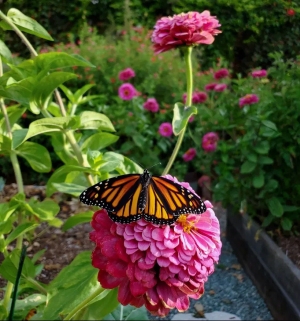 For many garden lovers, the chance to get outside, escape the laptop, and enjoy nature is the reason they have a house with a garden.
For many garden lovers, the chance to get outside, escape the laptop, and enjoy nature is the reason they have a house with a garden.
Gardening offers people the opportunity to relax and take time out from the pressures of modern life
Some people want to grow their own fruit, vegetables, and herbs, while others simply want to enjoy the birds, bees, and butterflies that visit their gardens.
Most garden owners know that wildlife loves a garden. It’s a great place for plants and creatures to flourish. The types of plants you choose will have a big impact on the wildlife in your garden.
Why Do Gardeners Need To Attract Wildlife?
Gardens in towns and cities enjoy a wide range of wildlife, while rural gardens can benefit from the more exotic species. The reasons for this are simple: plants and animals need each other, so you’d expect them to find a space that is beneficial to both of them.
If you have beautiful flowers, then birds will visit your garden to see what they’re like. They’ll groom the flowers, peck at the nectar, and may even build a nest on top.
Looking after your flower beds will encourage insects and other wild creatures too.
Attracting Wildlife Into Your Space
If you are ready to bring in the wildlife, from hedgehogs to pollinators, the list below will give you some idea of what plants to plant to encourage them along. So, grab your landscape gardening tools, and get building a wildlife-friendly garden.
Marigolds
Marigolds are pretty without being a very tough plant. They don’t like harsh conditions but do well in gardens where they’re sheltered from wind and rain.
They’re also a good choice for areas where the soil is dry since they’ll survive even when it’s bone dry. These plants are not just for wildflowers; some people use marigolds as their sole source of color in their gardens.
Nasturtiums
Nasturtiums attract bees, butterflies, and other pollinators, as well as being a food source for caterpillars. They are also an edible plant for humans, with a peppery taste that works well in salads.
Fennel
Fennel is another attractive plant for pollinators – bees love it. It’s also edible: the leaves can be used to flavor foods, or the stems can be pickled in jars or added to stews and roasts for extra flavor.
Bee Balm (Monarda didyma)
Bee Balm is a perennial, so it needs moderate maintenance in order to stay healthy and beautiful. It’s also used as an herbal remedy, either by itself or mixed with frankincense oil.
It has a slightly spicy scent, too, which appeals to bees. The bright red-orange leaves are small, but they’re also pretty so that they can make a good border plant too.
Yarrow
Yarrow is a perennial that prefers dry or semi-dry soil that’s not too fertile.
The stems are tall and thin and can reach up to 1.5 meters in height, which will attract animals, so it’s best to grow it near the back of your flower beds. It gets its name because of the way it was used to staunch wounds in battle.
Shift Frequency © 2022 – Plants That Will Make Your
Garden Buzz with Wildlife
